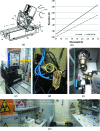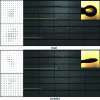P13, the EMBL macromolecular crystallography beamline at the low-emittance PETRA III ring for high- and low-energy phasing with variable beam focusing
- PMID: 28009574
- PMCID: PMC5182027
- DOI: 10.1107/S1600577516016465
P13, the EMBL macromolecular crystallography beamline at the low-emittance PETRA III ring for high- and low-energy phasing with variable beam focusing
Abstract
The macromolecular crystallography P13 beamline is part of the European Molecular Biology Laboratory Integrated Facility for Structural Biology at PETRA III (DESY, Hamburg, Germany) and has been in user operation since mid-2013. P13 is tunable across the energy range from 4 to 17.5 keV to support crystallographic data acquisition exploiting a wide range of elemental absorption edges for experimental phase determination. An adaptive Kirkpatrick-Baez focusing system provides an X-ray beam with a high photon flux and tunable focus size to adapt to diverse experimental situations. Data collections at energies as low as 4 keV (λ = 3.1 Å) are possible due to a beamline design minimizing background and maximizing photon flux particularly at low energy (up to 1011 photons s-1 at 4 keV), a custom calibration of the PILATUS 6M-F detector for use at low energies, and the availability of a helium path. At high energies, the high photon flux (5.4 × 1011 photons s-1 at 17.5 keV) combined with a large area detector mounted on a 2θ arm allows data collection to sub-atomic resolution (0.55 Å). A peak flux of about 8.0 × 1012 photons s-1 is reached at 11 keV. Automated sample mounting is available by means of the robotic sample changer `MARVIN' with a dewar capacity of 160 samples. In close proximity to the beamline, laboratories have been set up for sample preparation and characterization; a laboratory specifically equipped for on-site heavy atom derivatization with a library of more than 150 compounds is available to beamline users.
Keywords: 2θ-detector arm; low-energy data collection; phasing; softer X-rays; sulfur SAD; tunability; variable beam.
Figures






Similar articles
-
The beamlines of ELETTRA and their application to structural biology.Genetica. 1999;106(1-2):171-80. doi: 10.1023/a:1003757718266. Genetica. 1999. PMID: 10710723 Review.
-
BioMAX - the first macromolecular crystallography beamline at MAX IV Laboratory.J Synchrotron Radiat. 2020 Sep 1;27(Pt 5):1415-1429. doi: 10.1107/S1600577520008723. Epub 2020 Aug 5. J Synchrotron Radiat. 2020. PMID: 32876619 Free PMC article.
-
A high-throughput structural biology/proteomics beamline at the SRS on a new multipole wiggler.J Synchrotron Radiat. 2005 Jul;12(Pt 4):455-66. doi: 10.1107/S0909049505009131. Epub 2005 Jun 15. J Synchrotron Radiat. 2005. PMID: 15968122
-
BL-11C Micro-MX: a high-flux microfocus macromolecular-crystallography beamline for micrometre-sized protein crystals at Pohang Light Source II.J Synchrotron Radiat. 2021 Jul 1;28(Pt 4):1210-1215. doi: 10.1107/S1600577521004355. Epub 2021 Jun 1. J Synchrotron Radiat. 2021. PMID: 34212886 Free PMC article.
-
Designing a synchrotron micro-focusing beamline for macromolecular crystallography.Postepy Biochem. 2016;62(3):395-400. Postepy Biochem. 2016. PMID: 28132495 Review. English.
Cited by
-
Crystal structures of free and ligand-bound forms of the TetR/AcrR-like regulator SCO3201 from Streptomyces coelicolor suggest a novel allosteric mechanism.FEBS J. 2023 Jan;290(2):521-532. doi: 10.1111/febs.16606. Epub 2022 Sep 2. FEBS J. 2023. PMID: 36017630 Free PMC article.
-
Fast, automated, continuous energy scans for experimental phasing at the BioMAX beamline.J Synchrotron Radiat. 2023 Sep 1;30(Pt 5):885-894. doi: 10.1107/S1600577523005738. Epub 2023 Aug 1. J Synchrotron Radiat. 2023. PMID: 37526994 Free PMC article.
-
Structural Characterization of EnpA D,L-Endopeptidase from Enterococcus faecalis Prophage Provides Insights into Substrate Specificity of M23 Peptidases.Int J Mol Sci. 2021 Jul 1;22(13):7136. doi: 10.3390/ijms22137136. Int J Mol Sci. 2021. PMID: 34281200 Free PMC article.
-
Status and perspective of protein crystallography at the first multi-bend achromat based synchrotron MAX IV.J Synchrotron Radiat. 2025 May 1;32(Pt 3):779-791. doi: 10.1107/S1600577525002255. Epub 2025 Apr 4. J Synchrotron Radiat. 2025. PMID: 40184323 Free PMC article.
-
FMX - the Frontier Microfocusing Macromolecular Crystallography Beamline at the National Synchrotron Light Source II.J Synchrotron Radiat. 2021 Mar 1;28(Pt 2):650-665. doi: 10.1107/S1600577520016173. Epub 2021 Feb 25. J Synchrotron Radiat. 2021. PMID: 33650577 Free PMC article.
References
-
- Adams, P. D., Afonine, P. V., Bunkóczi, G., Chen, V. B., Davis, I. W., Echols, N., Headd, J. J., Hung, L.-W., Kapral, G. J., Grosse-Kunstleve, R. W., McCoy, A. J., Moriarty, N. W., Oeffner, R., Read, R. J., Richardson, D. C., Richardson, J. S., Terwilliger, T. C. & Zwart, P. H. (2010). Acta Cryst. D66, 213–221. - PMC - PubMed
-
- Arvai, A. (2015). The ADXV User Manual, http://www.scripps.edu/tainer/arvai/adxv/adxv_1.9.10/AdxvUserManual_v1.1....
-
- Bacher, R. (2007). Proceedings of the International Conference on Accelerator and Large Experimental Physics Control Systems (ICALEPS07), 15–19 October 2007, Knoxville, TN, USA, p. 217. TPPB27.
-
- Balewski, K., Brefeld, W., Decking, W., Franz, H., Röhlsberger, R. & Wicker, E. (2004). PETRA III Technical Design Report. DESY, Hamburg, Germany.
-
- Barthelmess, M., English, U., Pflüger, J., Schöps, A., Skupin, J. & Tischer, M. (2008). Proceedings of the 11th European Particle Accelerator Conference (EPAC’08), 23–27 June 2008, Genoa, Italy, p. 2320.
Publication types
LinkOut - more resources
Full Text Sources
Other Literature Sources

